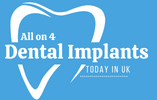Introduction to the Latest in All-on-Four Implant Technology
Technological Advances in All-on-Four Implants are revolutionizing the world of dentistry, offering a level of precision and durability once thought unattainable. Recent research, including a comprehensive study published in the International Journal of Oral & Maxillofacial Implants, highlights a remarkable success rate exceeding 98% over ten years for All-on-Four procedures. This statistic not only underscores the reliability of this technology but also sets the stage for a discussion on the continuous advancements that are shaping the future of dental implantology. As a prosthodontist deeply immersed in the field, I’ve witnessed these evolutions firsthand and am excited to share how they’re revolutionizing patient care.
Cornerstones of Modern All-on-Four Implants
The cornerstones of modern All-on-Four implants represent advancements that have transformed dental restoration, offering patients a reliable and efficient solution for full-arch tooth replacement. Here are the key aspects:
Material Innovations
The foundation of the latest Technological Advances in All-on-Four Implants lies in breakthroughs in materials science. Today, implants are predominantly crafted from titanium and zirconia, chosen for their exceptional strength, biocompatibility, and ability to integrate with bone tissue. These advancements not only contribute to the longevity of dental implants but also significantly reduce the risk of complications, offering a seamless blend with the natural aesthetics of the patient’s existing teeth. This evolution in materials ensures that implants are not just a solution for today but a lasting commitment to one’s oral health.
Precision and Customization Through Digital Dentistry
Digital dentistry has been a game-changer in the realm of Technological Advances in All-on-Four Implants, bringing about an era of precision and customization previously unimaginable. The use of digital imaging and 3D printing technology allows for meticulous planning of implant placement, tailored specifically to the unique anatomy of each patient’s jawbone. This level of detail ensures optimal placement, maximizing the potential for successful osseointegration and achieving the best possible aesthetic outcome. Furthermore, the ability to preview the expected results before the surgery increases patient confidence and satisfaction with the process.
In the following sections, we’ll delve deeper into how these Technological Advances in All-on-Four Implants are enhancing surgical techniques and improving the overall patient experience, continuing to push the boundaries of what’s possible in dental restoration.
Enhancements in Surgical Techniques and Patient Experience
One of the most significant Technological Advances in All-on-Four Implants is the development of minimally invasive surgical techniques. These new methods rely on precise pre-surgical planning enabled by digital imaging, allowing for smaller incisions and reduced impact on surrounding tissues. This approach not only minimizes discomfort during and after the procedure but also significantly shortens the recovery time, allowing patients to return to their daily lives much quicker. The emphasis on less invasive surgery has opened the door to dental implants for a broader range of patients, including those who may have been hesitant due to the prospect of a lengthy and painful recovery period.
Pain Management and Sedation Advances
Advances in pain management and sedation techniques have further transformed the All-on-Four implant procedure into a more comfortable experience for patients. Modern sedation dentistry offers a variety of options, from local anesthetics to conscious sedation, ensuring that patients feel minimal discomfort during the procedure. These advancements in pain management are not only about comfort; they also play a crucial role in reducing anxiety and fear associated with dental surgeries, making the journey towards a restored smile as stress-free as possible.
The Role of AI and Machine Learning
Artificial Intelligence (AI) and machine learning are at the forefront of the latest wave of Technological Advances in All-on-Four Implants, particularly in the planning and execution of All-on-Four implant procedures. AI algorithms can analyze vast amounts of data from dental records, imaging, and previous surgeries to predict the most favorable outcomes for individual patients. This predictive capability enables the creation of highly personalized treatment plans that consider the unique characteristics of each patient’s oral health status and bone structure, leading to higher success rates and more predictable results.
Machine learning also enhances the diagnostic process, allowing for the early detection of potential complications and the optimization of implant placement. By learning from each case, AI technologies are continually improving, refining the accuracy of predictions and treatment plans with each application. This not only elevates the level of care provided but also contributes to the field’s collective knowledge, pushing the boundaries of what is possible in dental restoration.
In the sections that follow, we’ll explore how ongoing care and monitoring innovations contribute to the long-term success of Technological Advances in All-on-Four Implants, further enhancing patient outcomes and satisfaction.
Ongoing Care and Monitoring Innovations
Ongoing care and monitoring innovations play a crucial role in ensuring the long-term success and durability of All-on-Four implants. Here’s how these advancements contribute to patient care:
Remote Monitoring and Post-operative Care
The post-operative phase of All-on-Four implant treatment has seen remarkable improvements thanks to innovations in remote monitoring technologies. Patients can now benefit from apps and devices that allow their dental professionals to monitor healing and implant integration progress in real-time, without the need for frequent in-office visits. This technology not only provides convenience for patients but also ensures that any complications or concerns are addressed promptly, significantly enhancing the success rate of the procedure.
Remote monitoring tools can track various metrics, such as bite force and temperature, which might indicate infection or issues with implant integration. By leveraging these technologies, we can offer personalized advice and adjustments to the patient’s care plan, enhancing comfort and outcomes. This level of ongoing care and attention to detail underscores the commitment to not just the success of the implant procedure but the long-term oral health and satisfaction of the patient.
The Impact on Patient Outcomes and Satisfaction
The culmination of advancements in materials, surgical techniques, AI and machine learning, and post-operative care has had a profound impact on the outcomes and satisfaction of patients opting for Technological Advances in All-on-Four Implants. With these technological advancements, we’re seeing evidence of improved longevity and success rates of implants, contributing to a significant increase in patient satisfaction. The integration of these innovations ensures that each step of the implant process, from initial consultation to final follow-up, is optimized for the best possible outcome.
Patients today can expect not only a more aesthetically pleasing result but also a functional, long-lasting solution to tooth loss. The ability to predict outcomes with greater accuracy, tailor treatment plans to individual needs, and provide comprehensive post-operative care has transformed the patient experience. This holistic approach to dental restoration, powered by technological advancements, not only enhances the quality of life for patients but also sets a new standard in dental care.
In the final section, we’ll discuss how embracing these Technological Advances in All-on-Four Implants can empower patients and dental professionals alike, guiding them towards making informed decisions and achieving the best possible results in their dental restoration journey.
Navigating Your Dental Restoration Journey
Navigating your dental restoration journey, especially when considering treatments like All-on-Four implants, requires careful planning and understanding of the process. Here’s a comprehensive guide to help you navigate this transformative journey:
Embracing Technology for a Brighter Smile
As we stand on the cusp of what’s possible in dental restoration, it’s clear that the future is bright for patients considering Technological Advances in All-on-Four Implants. The advancements in technology have not only improved the technical aspects of dental implants but have fundamentally changed the way we approach patient care. As a prosthodontist, I am continually amazed by the precision, predictability, and personalization that these innovations bring to our practice.
For those contemplating dental implants, my advice is to embrace these Technological Advances in All-on-Four Implants with an open mind. Ask your dental professional about how the latest in implant technology can be applied to your treatment plan. Inquire about the materials used, the role of digital dentistry in planning your procedure, and how AI might contribute to predicting your treatment outcomes. Understanding these elements can provide reassurance and confidence as you make decisions about your dental health.
Moreover, consider the benefits of minimally invasive surgical techniques and the advancements in pain management that make the procedure more comfortable than ever before. Take comfort in the fact that ongoing care and monitoring have evolved to ensure the best possible outcomes for your dental restoration journey.
Conclusion: A Future-Focused Approach to Dental Restoration
The journey through the Technological Advances in All-on-Four Implants underscores a significant shift toward a more patient-centered, efficient, and effective approach to dental restoration. These innovations not only enhance the functional and aesthetic outcomes of dental implants but also contribute to a higher standard of patient care and satisfaction.
As we look to the future, it’s exciting to consider what further advancements will emerge in the field of dental implantology. What remains constant, however, is the commitment to improving patients’ lives through enhanced dental solutions. Whether you are just beginning to explore the possibility of All-in-Four implants or are ready to take the next step, it’s an opportune time to benefit from the remarkable strides made in dental technology.
If you’re ready to explore how the latest Technological Advances in All-in-Four Implants can transform your smile and your life, I invite you to schedule a consultation at the Manchester Dental Implant Centre. Together, we can navigate your dental restoration journey, equipped with the best that modern dentistry has to offer.
In this era of technological innovation, your journey to a restored smile is supported by groundbreaking advancements that promise not just a better dental experience, but a better future. Let’s embark on this journey together, with confidence in the technology that makes exceptional dental health and aesthetics a reality for all.
FAQs
Modern All-on-Four implants primarily use titanium and zirconia, known for their strength, biocompatibility, and ability to integrate well with bone tissue
Digital dentistry utilizes 3D imaging and printing for precise implant placement, tailored to each patient’s unique jawbone structure, ensuring optimal outcomes
AI analyzes dental data to create personalized treatment plans, predict outcomes, and improve diagnostic accuracy, enhancing the success rates of the procedures.
Minimally invasive surgical techniques, advanced pain management, and sedation options reduce discomfort and shorten recovery times, making the procedure more patient-friendly.






